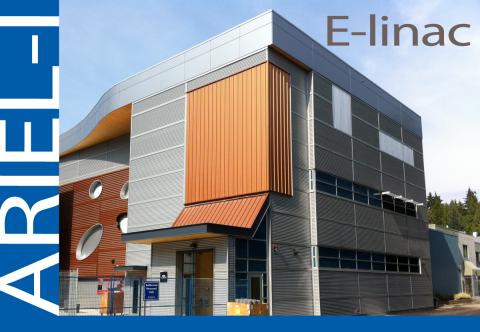
All hands are on deck this spring as the Accelerator Division concentrates their efforts on the installation and assembly of the electron linear accelerator, the state-of-the-art equipment at the heart of ARIEL, TRIUMF's new facility for the production of rare isotopes. The electron gun and the Low Energy Beam Transport (LEBT) are among several main components now residing in the e-hall, with more components and services to follow in the coming weeks, bringing the e-linac a significant step closer to its May 1st goal of the first beam delivery.
All experiments from ARIEL's e-linac will begin with an electron beam from the gun. To an unseasoned eye, the gun vessel looks like a large grey cylinder, belying the fact that within its vacuum-sealed walls, electrons are energized up to 300 000 volts. At such high voltage, air becomes ionized (the same process that causes lightning), so the gun vessel is filled with sulphur hexafluoride, a gas which doesn't ionize as easily. After being energized, the electron stream is "chopped" into a pulsed beam by applying a radiofrequency wave of 650 MHz. The beam exits the e-gun into the LEBT, where the ARIEL team can diagnose the beam's properties on its way to the injector cryomodule.
Both the electron gun and LEBT form the first section of the e-linac. Work is underway to install first cryomodule and connect all the pieces in preparation for the first beam delivery in early May. Along with existing components such as the helium cold-box, which cools the helium used in the cryomodule, and the klystron which powers the SRF cavity, the e-hall is filling up with other components which each complete a piece of the e-linac puzzle, such as the Faraday cage which shields the electron gun's high voltage power source. Design, construction, and testing of this equipment have been underway since 2010, even before the ARIEL building was completed. The project spans all areas of TRIUMF, engaging the efforts of physicists, engineers, designers, machinists, installers, and technicians.
The move is an extraordinary feat of logistics, requiring careful planning and some inventiveness. Equipment small enough to be transported in the industrial-sized elevator is moved by trolley, forklift, or palate jack, while larger pieces are lowered by crane through the hatchway which connects the e-hall to the Proton Hall above, using the Meson Hall's 50-tonne cranes and the e-hall's 10-tonne crane to move the largest equipment.
Meanwhile, the beam lines group has been busy marking the exact location where the e-linac pieces will be installed. Unlike proton beams, which have an envelope of about 10 mm, the electron beam starts at 2-3 mm and grows narrower as it accelerates. The allowed margin for error is only 2 mm longitudinally and 0.3 mm transversely! As a result, extreme precision is required in the placement of the e-linac equipment as it is assembled.
The e-hall continues to be a hotbed of activity as additional equipment is moved, water, compressed air, and electrical services are established, and the pieces are connected together. Thanks to the dedicated efforts of the ARIEL team, the e-linac is taking shape, paving the way for a future of world-leading science at TRIUMF.
-Lindsay Kroes, Communications Assistant
